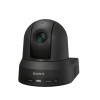Sony BRC-X400 Operating Instructions - Page 84
X tab, and digital certificate. To establish an 802.1X
 |
View all Sony BRC-X400 manuals
Add to My Manuals
Save this manual to your list of manuals |
Page 84 highlights
Note The import process becomes invalid if the selected file is not a certificate or the imported certificate is not allowed. Self-signed certificate generation A self-signed certificate can be generated in the camera to be used when [Use a self-signed certificate (For test use)] is selected from [Certificate options]. Click [Generate] to generate a self-signed certificate in the camera. Clicking [Generate] again after [Generate] has been clicked once will update the self-signed certificate stored in the camera. Note Make sure to set the date and time on the camera correctly before performing this operation. If the date and time are not correctly set, it may cause web browser connection problems. Before selecting [Generate] in [Self-signed certificate generation], click [OK] to select [Use a self-signed certificate (For test use)] in [Certificate options]. To display certificate information When the certificate has been set in the camera correctly, its information appears on [Status], [Issuer DN], [Subject DN], [Available period] and [Extended key usage]. Status Shows if the status of the certificate is valid or invalid. The following statuses are recognized. [Valid]: The certificate is correctly stored and set. [Invalid]: The certificate is not correctly stored and set. Possible causes are as follows: - [Use an external certificate] is selected and the private key password included in the certificate is not specified correctly. - [Use an external certificate] is selected and the private key password is specified in spite of the fact that the key pair in the certificate is not encrypted. - [Use an external certificate] is selected and the key pair is not included in the certificate. - [Use a self-signed certificate (For test use)] is selected without the self-signed certificate being generated. Note When the certificate to be imported is of PKCS#12 format and the private key password is not set correctly, "" is displayed in the boxes of [Issuer DN], [Subject DN], [Available period] and [Extended key usage]. Specify the correct private key password to confirm the information of the certificate. To delete the imported certificate or self-signed certificate Click [Delete] to delete the certificate or self-signed certificate imported to the camera. Private key password Enter the password for the private key information included in the certificate using up to 50 characters. This text box is active only when [Certificate options] is set to [Use an external certificate]. Leave the text box blank if the private key information included in the certificate is not encrypted. If no private key password is set in the camera, an active text field is displayed and this allows a password to be entered. If a private key password is already set, it is displayed as an inactive text field. Reset To change the once set private key password, click [Reset] and clear the current password. A new password can be entered. Note Click [Cancel] at the bottom of the menu if you want to cancel changing the private key password after clicking [Reset]. Doing so restores the other setting items in the SSL tab to the previous settings. 802.1X tab Configure the wired port-based authentication in compliance with the 802.1X standard. Notes • To use the 802.1X authentication function, you need knowledge of the 802.1X authentication and digital certificate. To establish an 802.1X network, you need to configure the authenticator, authentication server and other elements. For details on these settings, refer to the manual of the corresponding equipment. 84















